Past Ballparks of New York City
New
York City (Manhattan, Queens & Brooklyn)
September 29, 2007
By
Ken Schlapp
After we left Ridgewood, we headed
across the border and into Brooklyn for the rest of our tour. We
also stepped further into the past to the historic beginnings of
professional baseball in New York. That first stop in Brooklyn was
at the Union Grounds. William Cammeyer built the Union Grounds on
the streets of Williamsburg bounded by Harrison Avenue, Rutledge
Street, Lynch Street, and Marcy Avenue. This was one of the first
parks built in which games were played for a paid admission, which
started at 10 cents in 1862 and escalated to as much as 50 cents for
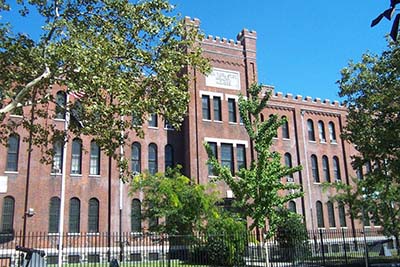 big
games through 1882. It was also the start of larger grandstands for
fans to come watch the highest level of baseball. In the winter, it
was even used as an ice-skating rink. big
games through 1882. It was also the start of larger grandstands for
fans to come watch the highest level of baseball. In the winter, it
was even used as an ice-skating rink.
Many of the best teams in Brooklyn
played at the Union Grounds including the Atlantics, the Putnam Club
and the Eckfords, which ended up being the first Major League team
to play there in 1872 as members of the National Association (a
precursor to the National League). Other Major League tenants of
the Union Grounds consisted of the Atlantics from 1873 to 1875, the
Mutuals from 1868 through the first season of the National League in
1876, and the Hartford Dark Blues (known as the Brooklyn Hartfords)
in 1877. However, the last Major League game played at the Union
Grounds took place on July 26, 1878 between the Providence Grays and
the Milwaukee Cream Citys. Many amateur and exhibition games
continued to take place there until it was demolished in 1883 in
part to build the 47th Regiment Armory, which remains
today. Again, it is unfortunate that we found no historic marker at
the Armory to signify the historic early games of Major League
baseball.
The Capitoline Grounds followed the
Union Grounds in design and intention as a ballpark to house
baseball and other events for a paid admission. It opened in 1864
in Bedford-Stuyvesant near the Union
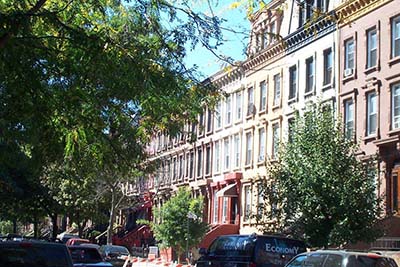 Grounds.
It was located between Halsey Street and Marcy, Putnam, and Nostram
Avenues. The Capitoline Grounds served as the home of the Atlantic
Club from 1864 through 1872, the only season the Atlantics were a
member of the National Association (and the only season the
Capitoline Grounds was used as a Major League ballpark). This was
also the home of the Excelsior and Enterprise Clubs as well as
several base ball games played on ice skates in the winter, but the
most important event to take place at the Capitoline Grounds was on
June 14, 1870, when the Atlantic Club defeated the Cincinnati Red
Stockings 8-7 in 11 innings. Yes, the first professional base ball
team managed by hall of famer Harry Wright. This was the fabled Red
Stockings first ever defeat after winning their first 89 games.
Once the Atlantic Club moved to the Union Grounds in 1873, amateur
and lesser matches continued to take place until 1879 and the
grounds were demolished in 1880 to build a housing development,
which can and was seen today by us. Grounds.
It was located between Halsey Street and Marcy, Putnam, and Nostram
Avenues. The Capitoline Grounds served as the home of the Atlantic
Club from 1864 through 1872, the only season the Atlantics were a
member of the National Association (and the only season the
Capitoline Grounds was used as a Major League ballpark). This was
also the home of the Excelsior and Enterprise Clubs as well as
several base ball games played on ice skates in the winter, but the
most important event to take place at the Capitoline Grounds was on
June 14, 1870, when the Atlantic Club defeated the Cincinnati Red
Stockings 8-7 in 11 innings. Yes, the first professional base ball
team managed by hall of famer Harry Wright. This was the fabled Red
Stockings first ever defeat after winning their first 89 games.
Once the Atlantic Club moved to the Union Grounds in 1873, amateur
and lesser matches continued to take place until 1879 and the
grounds were demolished in 1880 to build a housing development,
which can and was seen today by us.
The added development to our journey
was taking place in my car during our drives from site to site.
This was the last weekend of the current baseball season and the
Mets were in the midst of blowing a 7.5 game lead over the Phillies
over the final 17 games of the season. On this Saturday, the Mets
were playing the Marlins in a must win game and we were starting to
notice the fact that John Maine had a no-hitter going. We would not
let this get in the way of our journey, but we were intrigued every
time we got back into the car.
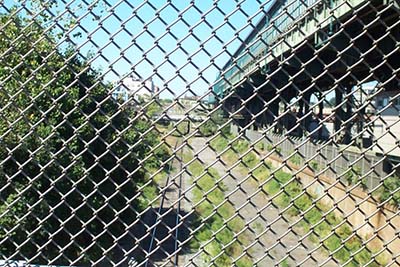 As
we moved forward in our journey and in a way, time itself, since we
were heading back towards the later professional ballparks. The
next park on our list was Eastern Park in East New York, which was
located on a lot between Eastern Parkway (now Pitkin Avenue), Vesta
Avenue (now Van Sinderen), Powell Street, and Sutter Avenue.
Eastern Park was the home of the Montgomery Ward led Brooklyn
Wonders of the Players League in 1890. However, the Players League
folded after the 1890 season and the Wonders combined with Charlie
Byrne’s Brooklyn Bridegrooms of the National League, and the
Bridegrooms continued to play in Eastern Park through the 1897
Season, before moving back to Washington Park for the 1898 season.
However, the most pertinent aspect of the Brooklyn Club’s tenure at
Eastern Park was the transportation hub of trolley and rail lines
around the park frequently forced the fans to dodge the trolleys on
their way in and out of the park. Hence, the beginning of the
“Trolley Dodger” moniker that was later shortened to Dodgers, which
is how the club has been known for most of its history. As
we moved forward in our journey and in a way, time itself, since we
were heading back towards the later professional ballparks. The
next park on our list was Eastern Park in East New York, which was
located on a lot between Eastern Parkway (now Pitkin Avenue), Vesta
Avenue (now Van Sinderen), Powell Street, and Sutter Avenue.
Eastern Park was the home of the Montgomery Ward led Brooklyn
Wonders of the Players League in 1890. However, the Players League
folded after the 1890 season and the Wonders combined with Charlie
Byrne’s Brooklyn Bridegrooms of the National League, and the
Bridegrooms continued to play in Eastern Park through the 1897
Season, before moving back to Washington Park for the 1898 season.
However, the most pertinent aspect of the Brooklyn Club’s tenure at
Eastern Park was the transportation hub of trolley and rail lines
around the park frequently forced the fans to dodge the trolleys on
their way in and out of the park. Hence, the beginning of the
“Trolley Dodger” moniker that was later shortened to Dodgers, which
is how the club has been known for most of its history.
Like many of the other ballparks I
have been discussing, you would never know that a Major League Park
once existed on this site. Eastern Park was demolished soon after
the Bridegroom finished playing the 1897 season. All that remains
today is an industrial area of little renown, next to an elevated
subway and train tracks, behind a fence with unkempt grass all
around it. Not at all a place where you could imagine that a major
League ballpark once thrived.
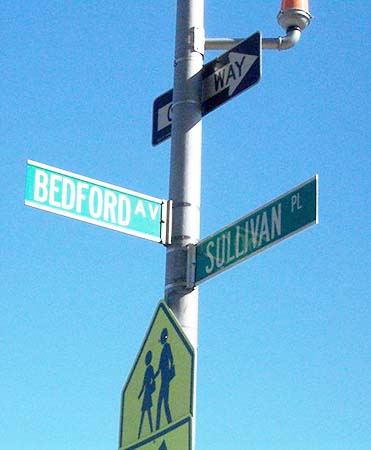 We
got back into the car in time to hear about the almost fight in the
Mets game between the Mets Jose Reyes and Marlins Miguel Olivo, but
Olivo’s punch hit nothing but air, and John Maine continued to work
his magic as the Mets piled on runs. Our next stop would be the
former site of Ebbets Field, where the Dodgers played from 1913
(when they were known as the Robins in honor of manager Wilbert
Robinson or “Uncle Robbie”) until they abandoned their fans for
California after the 1957 season. The Dodgers were loved by their
faithful Brooklyn fans, that were famous for calling the many losing
teams “Dem Bums”, but then saying “we’ll get em next year” in the
most Brooklyn of accents. Many of those fans never got over the
Dodgers leaving Brooklyn and still hope they will come back. I have
heard stories that my Uncle Walter once threw a radio out the window
after a Dodger loss and he never felt the same about baseball after
they left. My Uncle Norman did not go to a baseball game after the
Dodgers left until I took him to see the Tampa Devil Rays in 2003!
This was clearly a team with loyal fans that are still heartbroken
over the Dodgers departure, which was over a half-century ago. We
got back into the car in time to hear about the almost fight in the
Mets game between the Mets Jose Reyes and Marlins Miguel Olivo, but
Olivo’s punch hit nothing but air, and John Maine continued to work
his magic as the Mets piled on runs. Our next stop would be the
former site of Ebbets Field, where the Dodgers played from 1913
(when they were known as the Robins in honor of manager Wilbert
Robinson or “Uncle Robbie”) until they abandoned their fans for
California after the 1957 season. The Dodgers were loved by their
faithful Brooklyn fans, that were famous for calling the many losing
teams “Dem Bums”, but then saying “we’ll get em next year” in the
most Brooklyn of accents. Many of those fans never got over the
Dodgers leaving Brooklyn and still hope they will come back. I have
heard stories that my Uncle Walter once threw a radio out the window
after a Dodger loss and he never felt the same about baseball after
they left. My Uncle Norman did not go to a baseball game after the
Dodgers left until I took him to see the Tampa Devil Rays in 2003!
This was clearly a team with loyal fans that are still heartbroken
over the Dodgers departure, which was over a half-century ago.
Some of the more famous idiosyncrasies
of Ebbets field included the Abe Stark sign in right field “Hit
Sign, Win Suit” that would award any player who hit the sign with a
new suit, although it rarely happened. The ballpark was home to
nine pennants and one world championship in 1955, when they finally
beat the hated Yankees. By the mid 1950s, Ebbets Field was getting
old, needed repairs, and could not hold as many fans as some of the
newer stadiums. There had been discussions of moving the team to a
new
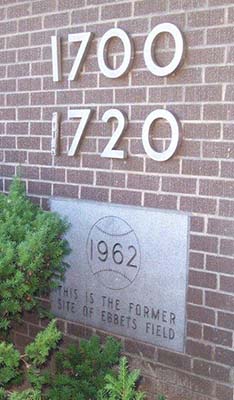 stadium
near the transit hub of Atlantic and Flatbush avenues and even to
Flushing, Queens, where the Mets would eventually play, but neither
came to fruition. Walter O’Malley decided that his best deal was to
move the Dodgers to Los Angeles along with the Giants moving to San
Francisco, which forever changed the baseball scene in New York, and
as I said before, most Brooklyn Dodger fans would never forgive them
for their abandonment. stadium
near the transit hub of Atlantic and Flatbush avenues and even to
Flushing, Queens, where the Mets would eventually play, but neither
came to fruition. Walter O’Malley decided that his best deal was to
move the Dodgers to Los Angeles along with the Giants moving to San
Francisco, which forever changed the baseball scene in New York, and
as I said before, most Brooklyn Dodger fans would never forgive them
for their abandonment.
I will also note that the Brooklyn
Eagles and the Brooklyn Brown Dodgers of the Negro Leagues also
called Ebbets Field home in the 1930s and 1940s. A few college and
professional football teams also played their home games at Ebbets
Field at various times. After the Dodgers left for California, LIU
used the ballpark for their 1959 season. The last professional game
believed to have been played in Ebbets Field was Between the Kansas
City Monarchs and the Brooklyn Stars of the Negro Leagues (the
Monarchs won 3-1), which was
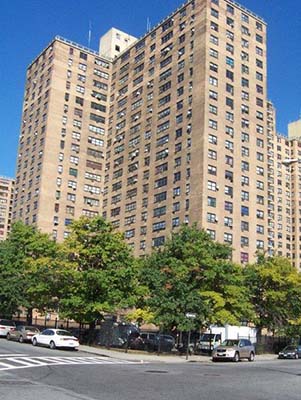 followed
by a senior game including Satchel Paige, who gave up a homer to
Herm Green. However, as reported in the Post in 2009, 12-year-old
Michael Hirsch may have hit the last home run in ballpark history
with an inside-the-parker in a Junior championship game later in
1959, but this has not been verified. followed
by a senior game including Satchel Paige, who gave up a homer to
Herm Green. However, as reported in the Post in 2009, 12-year-old
Michael Hirsch may have hit the last home run in ballpark history
with an inside-the-parker in a Junior championship game later in
1959, but this has not been verified.
Unlike our last few stops, there are
some plaques and markers to signify that Major League Baseball was
played off the corner of Sullivan Place and Bedford Avenue (and
Cedar Place {now McKeever Place} and Montgomery Street) in
Flatbush. When Ebbets Field was torn down in 1960, like the Polo
Grounds, it was replaced with the Ebbets Field Apartments. There is
a granite plaque by the entrance to the building indicating that the
houses were built in 1962 at the site of Ebbets Field. I had some
fun by having my loyal Dodger fan friend take a picture of me by the
plaque wearing my Giants shirt (with Shinjo on the back). There is
also an Ebbets Field sign over the parking lot next to the apartment
building. Jackie Robinson Playground is across the street, with Jackie Robinson High
School nearby as well. Also a beautiful Mural of Jackie Robinson
outside is plain to see when driving by.
Robinson Playground is across the street, with Jackie Robinson High
School nearby as well. Also a beautiful Mural of Jackie Robinson
outside is plain to see when driving by.
After visiting the most famous
Brooklyn baseball site, we headed back to the car to see how the
Mets were doing and were happy to learn that Maine still had his
no-hitter going into the 7th and the Mets had built up a
12-0 lead. Therefore, we had good news on our drive to Prospect
Park to see the Parade Grounds.
Prospect Park is Brooklyn’s version of
Central Park, and in fact, was designed by Frederick Law Olmstead
(and Calvert Vaux) in 1859, who also was one of the key designers of
Central Park. Although, the Parade Grounds was originally designed
as a military facility, it ended up being one of the most sought
after base ball diamonds in the city, especially considering base
ball was not allowed in Central Park at that time. From 1871 until
this day and beyond, baseball (and soccer and other sports)
continues to be played on this field. The biggest game to be played
at the Parade Grounds occurred between Charlie Byrne’s Brooklyn Base
Ball Club of the Inter-State Association of Professional Ball
Players and the Harrisburg Club on May 9, 1883, in which Brooklyn
won 7-1. Meaning, that this was the site of a Professional baseball
game. There is a plaque at the
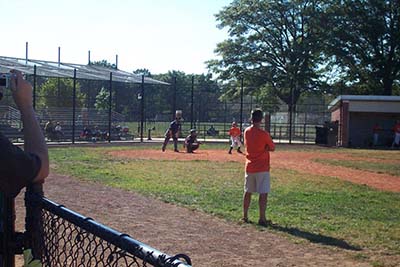 Parade
Grounds regarding the history of the field and park, as far as when
and why it was built, but no mention of a professional game by a
team that would eventually be called the Dodgers. We were lucky
enough to see a youth league game when we stopped by, so we could
effectively see the field in action. Like Central Park today, the
Parade Grounds at Central Park is a great place to play and watch
baseball. It is just a shame that the professional game has not
been commemorated. Parade
Grounds regarding the history of the field and park, as far as when
and why it was built, but no mention of a professional game by a
team that would eventually be called the Dodgers. We were lucky
enough to see a youth league game when we stopped by, so we could
effectively see the field in action. Like Central Park today, the
Parade Grounds at Central Park is a great place to play and watch
baseball. It is just a shame that the professional game has not
been commemorated.
When we got back to the car this time,
we were disappointed to learn that John Maine had given up an
infield single to Paul Hoover with 2 outs in the 8th
inning. Once again, the Mets attempt for their first no-hitter was
foiled, but the Mets did win 13-0, and John Maine only gave up that
one hit and struck out 14 Marlins to keep the Mets in a tie for 1st
place with the Phillies with one game left in the season.
NYC Ballparks Part V |